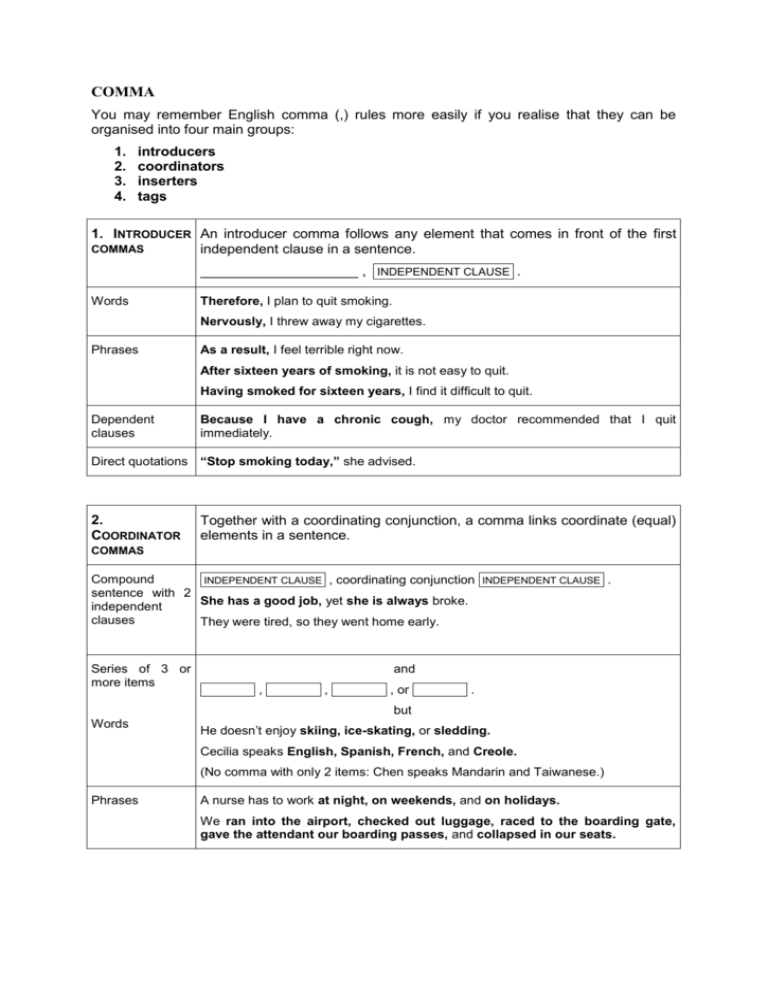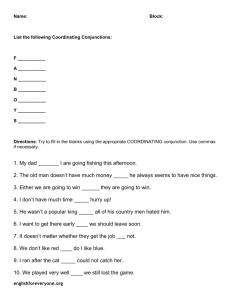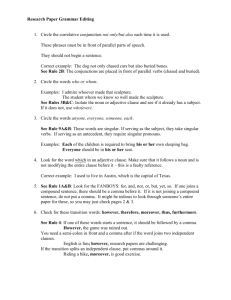English Punctuation Guide: Commas, Semicolons, Colons
advertisement

COMMA You may remember English comma (,) rules more easily if you realise that they can be organised into four main groups: 1. 2. 3. 4. introducers coordinators inserters tags 1. INTRODUCER An introducer comma follows any element that comes in front of the first COMMAS independent clause in a sentence. ____________________ , INDEPENDENT CLAUSE . Words Therefore, I plan to quit smoking. Nervously, I threw away my cigarettes. Phrases As a result, I feel terrible right now. After sixteen years of smoking, it is not easy to quit. Having smoked for sixteen years, I find it difficult to quit. Dependent clauses Because I have a chronic cough, my doctor recommended that I quit immediately. Direct quotations “Stop smoking today,” she advised. 2. COORDINATOR Together with a coordinating conjunction, a comma links coordinate (equal) elements in a sentence. COMMAS Compound INDEPENDENT CLAUSE , coordinating conjunction INDEPENDENT CLAUSE . sentence with 2 She has a good job, yet she is always broke. independent clauses They were tired, so they went home early. Series of 3 or more items and , , , or . but Words He doesn’t enjoy skiing, ice-skating, or sledding. Cecilia speaks English, Spanish, French, and Creole. (No comma with only 2 items: Chen speaks Mandarin and Taiwanese.) Phrases A nurse has to work at night, on weekends, and on holidays. We ran into the airport, checked out luggage, raced to the boarding gate, gave the attendant our boarding passes, and collapsed in our seats. 3. INSERTER COMMAS An inserter comma is used after and before any element that is inserted into the middle of an independent clause. INDEPENDENT , ____________________ , CLAUSE . Words My uncle, however, refuses to quit smoking. Phrases My father, on the other hand, has never smoked. There is no point in living, according to my uncle, if you don’t do what you enjoy. My aunt, his wife, died of lung cancer. Non-restrictive phrases and My cousins, grieving over their mother’s death, resolved never to smoke. clauses My mother, who just celebrated her fiftieth birthday, enjoys an occasional cigarette. Reporting verbs “I’ve tried to quit dozens of times,” she says, “but can’t.” in direct quotations 4. TAG COMMAS A tag comma is used when adding certain elements to the end of a sentence. INDEPENDENT CLAUSE Words , ____________________ My uncle believes in drinking a daily glass of wine, too. He appears to be in good health, however. Phrases He swims for an hour every day, for example. He also plays tennis, beating me most of the time. Tag questions It isn’t logical, is it? Direct quotations He laughs as he says, “I will outlive all of you.” SEMICOLON Using semicolons is not difficult if you remember that a semicolon (;) is more like a period than a comma. It is a very strong punctuation mark. Semicolon are used in three places: 1. Between 2 sentences that are closely connected in idea and are not linked with conjunctions 2. Before conjunctive adverbs and some transitional phrases 3. Between items in a series if the items themselves contain commas 1. BETWEEN SENTENCES Independent clause ; independent clause Alice is going to Harvard; She isn’t going to M.I.T. Computer use is increasing; computer crime is, too. The meeting adjourned at dawn; nothing had been accomplished. Use a semicolon before conjunctive adverbs such as however, therefore, nevertheless, moreover, and furthermore. You may also use a semicolon before some transition phrases such as for example, as a result, that is, in fact, etc. 2. BEFORE CONNECTORS Independent clause ; conjunctive adverb or transition phrase , independent clause Skiing is dangerous; nevertheless, millions of people ski. I have never been to Europe; in fact, I have never been outside my country. 3. BETWEEN ITEMS IN A SERIES I cannot decide which car I like best: the Ferrari, with its quick acceleration and sporty look; the midsize Ford Taurus, with its comfortable seats and ease of handling; or the compact Geo, with its economical fuel consumption. COLON Colons (:) are usually used to introduce: 1. a list 2. a long quotation 3. a subtitle 4. a final fact or explanation 1. LISTS Libraries have two kinds of periodicals: bound periodicals and current periodicals I need the following groceries: eggs, milk, and coffee. The causes of the U.S. Civil War were as follows: the economic domination of the North, the slavery issue, and the issue of states’ rights versus federal intervention. Note: Do not use a colon to introduce a list after the verb to be unless you add the following or as follows. To me, the most important things in life are health, happiness, good friends, and a lot of money. To me, the most important things in life are the following: health, happiness, good friends, and a lot of money. 2. LONG QUOTATIONS Use a colon to introduce a quotation longer than three lines. This type of quote is indented on both sides, and no quotation marks are used. As Albert C. Baugh and Thomas Cable state in their book, The History of the English Language: There is no such thing as uniformity in language. Not only does the speech of one community differ from that of another, but the speech of different individuals of a single community, even different members of the same family, is marked by individual peculiarities. 3. SUBTITLES Use a colon between the main title and the subtitle of a book, article, or play. A popular book on nonverbal communication is Samovar and Porter’s Intercultural Communication: A Reader. The name of an article from the New York Times is “Space Station: Dream or Reality?” 4. FINAL FACT OR EXPLANATION There is only one explanation for Mary’s behaviour: she is jealous. (From Oshima, A. & Hogue, A. (1991). Writing academic English. Menlo Park, CA: Addison-Wesley.) Practice Add commas wherever they are necessary. (Not all sentences need them, and some sentences need more than one.) Name the function of each comma (introducer, coordinator, inserter, or tag) 1. The advertising industry which is one of the largest industries in the United States employs millions of people and spends billions of dollars. 2. A company that wants to be successful must spend a great of money on advertising its products. 3. Advertising is essential to the free enterprise system yet it can sometimes be very annoying. 4. Every minute of the day and night people are exposed to ads on television on billboards in the newspapers and in magazines. 5. You cannot even avoid advertising in the privacy of your own car or your own home for advertisers have begun selling their products in those places too. 6. In the last few years advertising agencies have started to hire young people to hand out circulars on street corners and in parking lots. 7. You can often find these circulars stuck on your windshield thrust through the open windows of your car stuffed in your mailbox or simply scattered on your front doorstep. 8. Because Americans are exposed to so much advertising they have become immune to it. 9. As a result advertisers have to make louder commercials use brighter colours and hire sexier models to catch the public’s attention. 10. Many people object to commercials that use sex as a sales strategy. 11. Sexy commercial that sell everything from toothpaste to automobiles seem to imply that you will become sexier if you buy the product. 12. Sex is used in many cigarette and liquor ads for example. 13. The women in such ads are often dressed in revealing clothes and are surrounded by handsome men and the men in such ads are always extremely handsome and virile. 14. As everyone knows drinking and smoking do not make you sexy or virile. 15. On the contrary drinking makes you fat and smoking makes you sick. 16. The government is considering a ban on sex in cigarette and liquor ads because of their potentially harmful effect on teenagers. 17. The government is considering a ban but no action has been taken yet. 18. If such an action is taken my boyfriend the Marlboro man will be out of a job. 19. Catherine Deneuve who sells automobiles and perfume would lose some work too.









